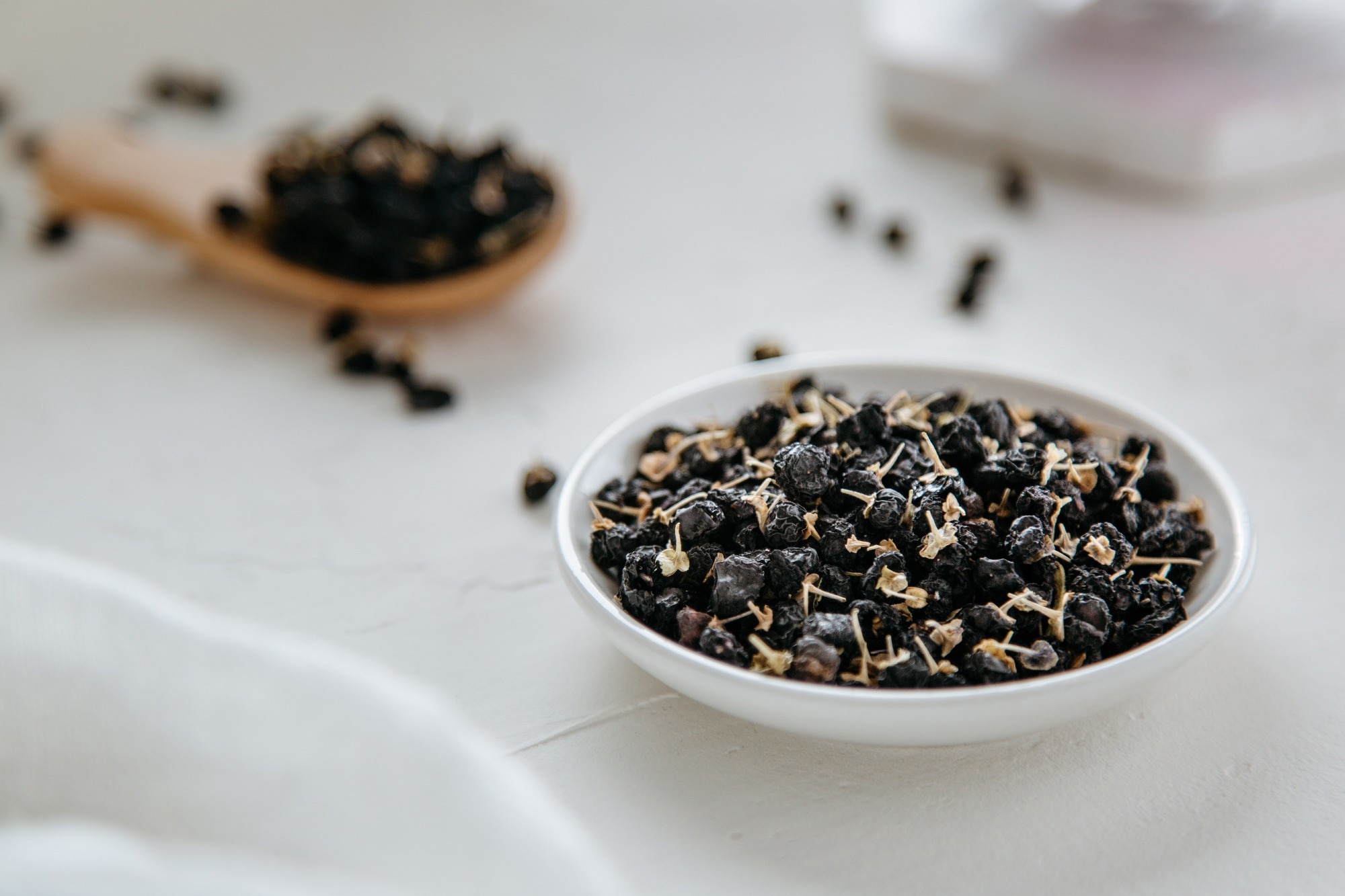In a recent review published in the Nutrients Journal, researchers reviewed existing data on the pharmacological and biological effects of the components of Lycium ruthenicum Murray (LRM) fruits such as black goji berries.
 Study: Black Goji Berry (Lycium ruthenicum Murray): A Review of Its Pharmacological Activity. Image Credit: Tim Chow/Shutterstock.com
Study: Black Goji Berry (Lycium ruthenicum Murray): A Review of Its Pharmacological Activity. Image Credit: Tim Chow/Shutterstock.com
Background
The LRM plant, black wolfberry or black goji berry, thrives on China's Qinghai-Tibet plateau deserts. In traditional Chinese medicine, LRM is commonly used as an herbal remedy to treat cardiovascular disease, inflammation, weariness, and other medical issues.
According to research, LRM is high in functional phytochemicals such as polysaccharides and anthocyanins and has a wide range of pharmacological effects.
About the review
In the present review, researchers described the health benefits of consuming LRM based on studies retrieved from PubMed, Web of Science, and Google Scholar, published in English.
Nutritional contents and properties of black wolfberry
LRM fruits contain carbohydrates (67 g/100 g DW), dietary fiber (12 g/100 g DW), proteins (11.5 g/100 g DW), ash (6.3 g/100 g DW), fat (3.0 g/100 g DW), organic acids (4.7 g/100 g DW), vitamins (12.4 g/100 g DW), macroelements (22 g/100 g DW), microelements (129 g/100 g DW), carotenoids (1.5 g/100 g DW), anthocyanins (25 g/100 g DW), and polysaccharides (31 g/100 g DW).
The high tannin, phenol, and monomeric anthocyanin content in black wolfberry confers strong antioxidant properties.
Constituents such as polysaccharides, anthocyanins, phenylpropanoid derivatives, polyphenolic glycosides, and seed oils confer anti-inflammatory, anti-aging, anti-cancer, organoprotective, anti-radiation, immunomodulatory, and tyrosine-inhibitory properties.
In addition, LRM consumption helps prevent fatigue, obesity, diabetes, and influenza virus infections.
Biological mechanisms underlying the pharmacological effects of black wolfberry
LRM fruit extracts, including anthocyanins, can lower tumor necrosis factor-alpha (TNF-α), interleukin (IL)-1β, 2, 6, cyclooxygenase 2 (COX-2), and phosphorylated nuclear factor kappa-light-chain-enhancer of activated B cell component p65 (p-NF-κBp65) levels.
Studies have also reported that LRM extracts can lower serum aging markers such as advanced glycation end products (AGEs), malondialdehyde (MDA), lipofuscin levels, and age-related gene (age-1) expression and improve amino acid metabolism.
In C57BL/6 mice, anthocyanins enhanced cognition by improving spatial learning, memory abilities, and cell viability.
In human breast cells, LRM fruit extracts have demonstrated antiproliferative activity and the activation of p21, p53, cyclin E, cyclin-dependent kinase 4 (CDK4), caspase3, and Bcl-2-associated X protein (Bax).
The levels of IL-4, IL-10, superoxide dismutase (SOD)-2,3, and catalase (CAT) can increase following LRM consumption.
In addition, LRM extracts can increase lifespan, oxidative resistance, irradiation tolerance, and the expression of genes such as daf-12,16, sirtuin-type domain-containing protein 2.1 (sir-2.1), c-Jun N-Terminal protein kinase 1 (jnk-1), and heat shock protein 16.2 (hsp-16.2).
Furthermore, LRM anthocyanins and fruit extracts are hepatoprotective. They can improve histological damage and reduce serum aspartate aminotransferase (AST), alanine transaminase (ALT), lactate dehydrogenase (LDH), and Fas/Fas ligand (FasL) messenger ribonucleic acid (mRNA) expression levels. In addition, they can reduce the size of fat droplets in the liver.
Polysaccharides in LRM can reduce pancreatic cell proliferation, tumor size, tumor weight, Ki67, the cluster of differentiation 31 (CD31), phosphorylated glycogen synthase kinase 3β (p-GSK-3β), B cell lymphoma 2 (Bcl-2), phosphorylated protein kinase B (p-AKT), phosphorylated focal adhesion kinase (p-FAK), β-Catenin, p-P38, and caspase-3 and nine levels, and increase apoptosis. Polysaccharide intake can inhibit replication by arrest by resting phase (G0)-growth 1 phase (G1).
In addition to anthocyanins and polysaccharides, polyphenolic glycosides confer neuroprotective properties by decreasing d-gal-induced neuronal apoptosis, Receptor for Advanced Glycation End-products (RAGE), beta-secretase enzyme 1 (BACE-1), amyloid beta protein 42 (Aβ42), glial fibrillary acidic protein (GFAP), ionized calcium-binding adapter molecule 1 (Iba-1), p-JNK, Bax/Bcl-2 ratio, and caspase-3 levels, and increasing cell viability and nuclear factor erythroid 2–related factor 2 (Nrf2) expression. In addition, they can improve learning, memory impairments, memory, passive avoidance, cell viability, and morphologic changes.
LRM fruit extracts have demonstrated cardioprotective effects by decreasing creatine kinase-myocardial band (CK-MB) and LDH activities (amelioration of the myocardial histopathology), fiber necrosis, the number of inflammatory cells, and myocardial tissue (improved myocardial tissue damage).
LRM intake can protect against radiation injury by reducing caspase-3, P53, and apoptosis and increasing thymus index, spleen index, and deoxyribonucleic acid (DNA) content.
LRM extracts can modulate immune function by increasing B and T lymphocyte proliferation, macrophage phagocytosis, serum hemolysin formation, and anti-inflammatory cytokine levels.
LRM extracts and polysaccharides can lower fatigue by decreasing oxidative stress, blood urea nitrogen (BUN), triglyceride (TG), creatine phosphokinase (CPK), LDH, and MDA levels, increasing SOD, glucose, and glutathione peroxidase (GPx) levels, and TG mobilization, and preventing lipid oxidation.
LRM fruit extracts, seed oils, and phenylpropanoid derivatives confer anti-obesity and anti-diabetic properties by decreasing Peroxisome Proliferator-Activated Receptor-γ (PPAR-γ), fatty acid synthase (FASN), and sterol regulatory element-binding transcription factor 1 (SREBP1) expression, increasing Carnitine palmitoyltransferase (Cpt) levels, and inhibiting pancreatic lipase activity.
Based on the review findings, LRM, a nutritional supplement with numerous pharmacological properties, has potential as a preventative measure against chronic cardiometabolic and inflammatory diseases.
However, the safety and efficacy of LRM in humans are yet to be confirmed due to insufficient research at cellular and animal levels. Further clinical research is needed to verify the effectiveness of LRM in preventing these diseases.